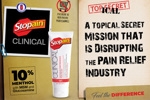
Ready, Set,..Ouch!!! Help Y...
VIEW >

A Topical Secret Mission th...
VIEW >

Not yet a Pro Portal member? Sign up here.
Chiropractors, Physical Therapists, Massage Therapists and other Hands-On Healthcare Professionals are an essential health and wellness resource for individuals of all ages. We partner closely with these professionals on helping people perform better and move ‘pain-free’.
Our topical pain relief products were specifically formulated with these hands-on healthcare professionals (and their patients) in mind. Our fast-acting formulation with penetration enhancers plus 10% menthol, MSM, Glucosamine is like no other. Embracing hands-on healthcare professionals and topical pain relief solutions like Stopain® Clinical provides patients and their families with the ultimate wellness solution.
Visit our clinic locator to find a healthcare professional in your community.

Conventional medicine only takes some COVID-19 survivors and especially “long haulers” so far. I’ve consulted numerous long haulers, and unconventional therapies are not only a reasonable option, but a necessity. Especially with long-term symptoms like aches and pains, exhaustion, shortness of breath, lack of energy and fatigue, neck pain, shoulder pain, joint swelling and pain, chest pain, dizziness, difficulty concentrating, headache, loss of smell, poor sleep quality and cognition challenges.
Post-acute COVID-19 or “long COVID patients” are defined as those with the presence of symptoms extending beyond three weeks from the initial onset of symptoms.
Long-Haul Syndrome is reserved for chronic COVID-19 symptoms extending beyond 12 weeks.1 The top symptoms post-acute COVID-19 patients consult me for have been musculoskeletal aches and pains, headaches, fatigue and shortness of breath.
Viremia related to COVID-19 causes microvascular thrombotic processes that can cause cellular and multiple organ system dysfunction — therefore treatment will require a multi-specialty coordination of approaches. The residual symptoms seem to be a consequence of direct tissue invasion.
A good history and symptoms list can give the practitioner a sense of the system(s) affected. The three key systems that seem to be affected are the cardiovascular, pulmonary and neurologic systems.
For example, myocardial injury, thromboembolic disease, myocardial inflammation, myocarditis, and cardiac arrhythmias will translate into “weakness,” “I look pale” or exertion “tiredness.” Adverse pulmonary consequences from interstitial thickening, fibrosis, diminished respiratory muscle strength, and decreased lung function will translate to “I’ve had to stop most (sports) activities,” “shortness of breath,” “chest tightness” (moderate or mild), “fatigue” and “headache.”
If the virus infiltrated the nervous system, symptoms will translate into “body aches,” “brain fog” and “concentration” challenges. Direct invasion of the olfactory nerve leads to anosmia (loss of smell).
To date, the most common long-term neurologic symptoms after COVID-19 are headache, vertigo and chemosensory dysfunction — anosmia and loss of taste (ageusia).6,7,8,9 Because loss of smell is one of the early symptoms in the majority of acute-stage COVID-19 cases, in my office I’m testing every patient for smell using essential oils along with forehead temperatures.
Symptoms spike dramatically in the days after overdoing an activity — physical, cognitive or social efforts. When they say they are “tired,” it’s not like being tired. It’s like you’ve been drugged. I get the sense they feel OK one minute and then 10 minutes later, they feel run over by a bus. I am used to the “good day, bad day feeling” patient, but this is a whole new level of that.
Even people who never experienced symptoms of COVID-19 are expressing symptoms related to chronic stress and feelings of isolation and loneliness.3,10
COVID-19 creates a direct viral attack on the vessels, joints or nerves. The virus has been detected in every cell type and tissue in the body.
It involves multiple organs besides the vascular system, respiratory system, and the central and peripheral nervous system. This is the way I explain post-COVID-19 symptoms: your blood vessels have been compromised.
It may stem from a few possible sources:
>Hypoxia — You have a lack of oxygen to the tissues due to respiratory problems during the infection. Hypoxia is an insufficient amount of oxygen reaching the tissues. Mitochondria need oxygen to create ATP. ATP is the energy required for cells to carry out their specific functions: nerve impulses, tissue repair, muscle contraction, the synthesis of biochemical agents within cells, and more — all these actions require ATP. Any movement or metabolic process needs ATP. A constant supply is needed to maintain cellular processes for life.
Lack of motion — Being bed-bound for days or weeks and lack of motion can cause low blood supply; blood is stagnant and not reaching the tissues because it is unable to flow to them (the extreme is blockage, i.e. stroke). A lack of blood means a lack of oxygen to the tissues. A lack of oxygen to the tissues is very painful. The virus may have created damaged cells that caused low blood oxygen (blood isn’t saturated with oxygen) from defective hemoglobin. Your tissues have had a lack of oxygen to intake. See how we are back to hypoxia.
Blood clots — You may feel muscle aches and pain or fatigue (list their symptoms) from COVID-19. If people have a bunch of small clots in the lungs, that can continue to fatigue for a long period of time — even after the clots are gone — if there’s damage to the blood vessels.
There is no “one remedy” for all of these symptoms for sufferers or COVID-19 survivors. I am helping patients manage the condition while they are learning to pace themselves.
My key messages for long haulers battling fatigue are to prioritize rest and relaxation, avoid pushing yourself, learn to balance activity and breaks, and improve sleep.
Other areas to work on include:
The best thing is to listen to your body. If you know that something’s pushed you over the edge in the past, then don’t repeat it.
Do something active, but for less time or less strenuously. I start with “marching in place” and moving the arms overhead. This allows patients to do this at home or outside but certainly close to home. I literally start with two-minute bouts. If that goes well, increase the two-minute march in place to several times a day. I monitor the number of steps on patients’ smart phones.
Review the patients’ personalized diet and nutrition, and also any recent lab analysis (request these for your patients even if they are 6-12 months old). This is good for your telehealth discussion, and a good time to order off-the-shelf stool tests, genetic tests, Omega Oils Index testing, nitric oxide testing, zinc testing, stress tests, etc.
Topical gels are provided to every patient and they are taught how to self-massage into aches and pains. Topicals with menthol, MSM and glucosamine self-massaged into the neck are patient favorites. I have also found a topical gel that is effective for head- ache relief. I use a similar approach — the patient applies behind each ear and on the back of the neck and they can reapply as needed. This solution has been very timely given the occurrence of headaches with many patients who are COVID-19 survivors dealing with symptoms.
Many of the most at-risk individuals for coronavirus are dehydrated and overweight to begin with, making hydration testing and body composition analysis important tools. My top supplement recommendation is a lesser-known immune enhancer — oral peptides FRAG B4 and BPC 157 (integrative peptides). My favorite immune/lymphatic flow system exercise is the body-weight swing — and every patient needs this.
As part of the body’s natural immune function, we can all appreciate the healing benefits of the lymphatic system. The lymph system, which is the body’s second circulatory system, consists of a connected network of tissues and organs that helps to deliver nutrients and filter out water, bacteria, waste products and other debris of cell metabolism.
Unfortunately, unlike your veins, the lymph system is not a closed system and has no central pump, like your heart, to support its cleansing. So, for many years I have been utilizing a negative pressure device that helps with lymph flow and drainage while also providing patients with a nice massage-like experience — it’s a very relaxing treatment. Negative pressure therapy is also extremely beneficial for those who have swelling in the body from sports injuries, damaged or blocked vessels in the lymph system following surgery, fibromyalgia, arthritis, congestion, and post-cancer treatment. This treatment literally creates “space” in the fascial structures. Athletes especially appreciate the increased fascial range this therapy provides.
COVID-19 may cause people to experience a lengthy recovery after their severe acute illness, or the coronavirus itself may cause long-term complications. Your emotional support as a doctor of chiropractic cannot be overestimated. A multidisciplinary approach of therapeutic interventions will be required. Don’t miss out on who should be helping COVID-19 survivors suffering long-haul symptoms.
JEFFREY TUCKER, DC, is the current president of the ACA Rehab Council. He practices in Los Angeles, Calif., and can be reached at DrJeffreyTucker.com.
References
1.Greenhalgh T, Knight M, A’Court C, Buxton M, Husain L. Management of post-acute Covid-19 in primary care. BMJ. 2020;370:m3026. doi:10.1136/bmj.m3026PubMedGoogle ScholarCrossref
2.Maley JH, Brewster I, Mayoral I, et al. Resilience in survivors of critical illness in the context of the survivors’ experience and recovery. Ann Am Thorac Soc. 2016;13(8):1351-1360. doi:10.1513/AnnalsATS.201511-782OCPubMedGoogle ScholarCrossref
3.Carfì A, Bernabei R, Landi F; Gemelli Against COVID-19 Post-Acute Care Study Group. Persistent symptoms in patients after acute COVID-19. JAMA. 2020;324(6):603-605. doi:10.1001/jama.2020.12603
ArticlePubMedGoogle ScholarCrossref
4.Tenforde MW, Kim SS, Lindsell CJ, et al; IVY Network Investigators; CDC COVID-19 Response Team; IVY Network Investigators. Symptom duration and risk factors for delayed return to usual health among outpatients with COVID-19 in a multistate health care systems network: United States, March-June 2020. MMWR Morb Mortal Wkly Rep. 2020;69(30):993-998. doi:10.15585/mmwr.mm6930e1PubMedGoogle ScholarCrossref
5.Puntmann VO, Carerj ML, Wieters I, et al. Outcomes of cardiovascular magnetic resonance imaging in patients recently recovered from coronavirus disease 2019 (COVID-19). JAMA Cardiol. Published online July 27, 2020. doi:10.1001/jamacardio.2020.3557
ArticlePubMedGoogle Scholar
6.Rajpal S, Tong MS, Borchers J, et al. Cardiovascular magnetic resonance findings in competitive athletes recovering from COVID-19 infection. JAMA Cardiol. Published online September 11, 2020. doi:10.1001/jamacardio.2020.4916
ArticlePubMedGoogle Scholar
7.Zhao YM, Shang YM, Song WB, et al. Follow-up study of the pulmonary function and related physiological characteristics of COVID-19 survivors three months after recovery. EClinicalMedicine. 2020;25:100463. doi:10.1016/j.eclinm.2020.100463PubMedGoogle Scholar
8.Huang Y, Tan C, Wu J, et al. Impact of coronavirus disease 2019 on pulmonary function in early convalescence phase. Respir Res. 2020;21(1):163. doi:10.1186/s12931-020-01429-6PubMedGoogle ScholarCrossref
9.Zubair AS, McAlpine LS, Gardin T, Farhadian S, Kuruvilla DE, Spudich S. Neuropathogenesis and neurologic manifestations of the coronaviruses in the age of coronavirus disease 2019: a review. JAMA Neurol. 2020;77(8):1018-1027. doi:10.1001/jamaneurol.2020.2065
ArticlePubMedGoogle ScholarCrossref
10.Galea S, Merchant RM, Lurie N. The mental health consequences of COVID-19 and physical distancing: the need for prevention and early intervention. JAMA Intern Med. 2020;180(6):817-818. doi:10.1001/jamainternmed.2020.1562
ArticlePubMedGoogle ScholarCrossref